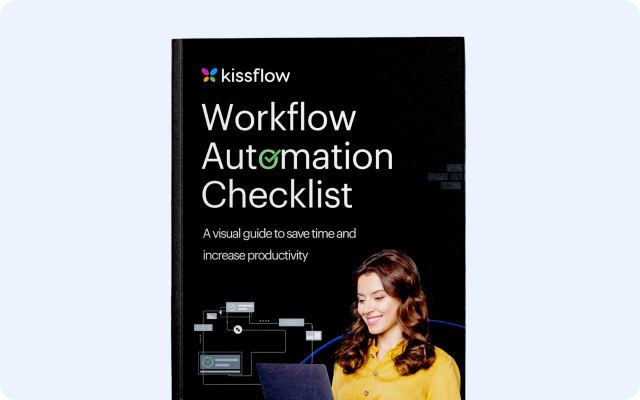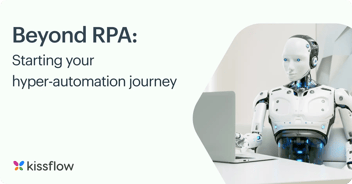
- >
- Workflow>
- What the Gartner Magic Quadrant Really Means for Hyperautomation
What the Gartner Magic Quadrant Really Means for Hyperautomation
Why CIOs actually care about Gartner's Magic Quadrant
Let's be honest: when you're evaluating enterprise technology, the Gartner Magic Quadrant (MQ) feels like the industry's report card. It helps you avoid catastrophically bad decisions and shows your CFO that you're not just picking vendors based on which sales rep bought you the nicest lunch.
But here's what most people miss: Gartner doesn't have a single "Hyperautomation Magic Quadrant." Why? Because hyperautomation isn't one tool. It's an orchestrated use of multiple technologies working together.
Think of it this way: You wouldn't ask "What's the best tool for building a house?" You'd ask about framers, electricians, plumbers, and architects. Hyperautomation is similar. It requires workflow automation, RPA, AI integration, analytics, and low-code development all working in concert.
Gartner forecasts that hyperautomation-enabling software will reach $720 billion in 2023. That's not just one market—it's an ecosystem.
So when evaluating platforms like Kissflow, you need to understand both what Gartner looks for and where their framework has blind spots.
The five pillars Gartner uses to evaluate hyperautomation
Gartner doesn't measure vendors on vibes. They assess specific capabilities across five critical areas:
1. Process orchestration and workflow automation
This is the foundation. Can users design, monitor, and optimize workflows across departments? Gartner looks for ease of design, reusability, and operational visibility.
The Kissflow angle: We're not trying to be everything to everyone. Kissflow excels at structured workflows with conditional logic, SLAs, notifications, and role-based triggers. Whether it's employee onboarding, purchase approvals, or customer onboarding, the drag-and-drop interface works for both technical and non-technical users.
Unlike task automation tools that only handle single steps, Kissflow workflows are dynamic and multi-step—handling handoffs across departments the way real work actually happens.
2. RPA integration
Can the platform work with robotic process automation tools to handle legacy systems that don't have APIs?
Here's the reality: Kissflow doesn't build proprietary RPA (because frankly, why compete with UiPath and Automation Anywhere?). Instead, we integrate with leading RPA platforms.
The global RPA market was valued at $28.31 billion in 2024 and is expected to reach $211.06 billion by 2034, growing at 25 percent annually. Rather than reinvent the wheel, Kissflow lets you use best-in-class RPA bots for data extraction and validation while managing the larger workflow context in our platform.
3. Low-code and no-code development
The future belongs to platforms that support both citizen developers (business users) and IT developers. Gartner calls this fusion teams—where business and IT collaborate on automation projects.
The numbers tell the story:
- By 2025, 70 percent of new applications will use low-code or no-code technologies
- 84 percent of enterprises have adopted low-code development tools to reduce IT strain
- 72 percent of users can build and launch apps using low-code tools in under three months
Kissflow supports both ends of this spectrum:
- Process owners can build and deploy workflows using no-code tools
- IT teams can extend workflows using low-code components, APIs, and reusable logic
This flexibility meets Gartner's vision of empowering both business and IT to solve problems together.
4. AI and machine learning
Gartner now expects platforms to offer intelligent document processing, natural language processing, classification, and prediction. AI isn't optional—it's table stakes.
Kissflow's approach: AI is embedded where it adds value, not bolted on as a marketing checkbox. Our platform offers AI-based capabilities for decision automation, document parsing, and form recommendations.
By 2024, over 50 percent of IDP solutions incorporate advanced AI and NLP features, and Kissflow is part of that wave—using AI to auto-classify documents, predict process improvements, and generate templates based on historical usage.
5. Governance and scalability
CIOs fear losing control when automation spreads across departments. Gartner evaluates whether platforms provide audit trails, role-based permissions, reusable components, and policy-based controls.
Why this matters: 70 percent of large enterprises will have over 70 concurrent hyperautomation initiatives by 2024. Without governance, that's chaos.
Kissflow addresses this head-on:
- Centralized governance dashboard
- Complete audit logs
- User-role permissions
- Reusable components
- Policy-based deployment controls
This governance-first approach aligns with Gartner's call for hyperautomation that scales without creating shadow IT.
Where Kissflow fits Gartner's emerging priorities
Gartner's recent reports on digital transformation emphasize four critical needs:
- Clear IT backlogs The average IT department has a 12-18 month backlog of application requests. 41 percent of businesses already have active citizen development programs to address this.
- Enable business-led development Nearly 60 percent of custom apps are now created by employees outside the IT department. Business users aren't waiting for IT anymore—they're building solutions themselves.
- Deliver automation with quick ROI Companies need wins, not multi-year transformation programs. Some no-code implementations have achieved ROI as high as 2,560 percent.
- Support composable enterprise models Modern businesses need systems that integrate easily and allow flexible rollouts.
Kissflow directly addresses all four:
- It helps CIOs clear backlogs of departmental workflows that ERP systems don't cover
- It supports citizen development at scale with appropriate oversight
- It delivers faster go-live timelines—reducing 5-month projects to 1 month
- It fits into composable architectures, integrating with existing systems
Beyond the Magic Quadrant: What Gartner doesn't tell you
While valuable, the Magic Quadrant has limitations. Here's what you need to know:
1. Market presence ≠ right fit
Some vendors rank high because they're everywhere, not because they're best for your use case. If you have a backlog of 50 departmental applications, a nimble platform like Kissflow might serve you better than an enterprise giant that takes 6 months to implement.
2. Over-indexing on RPA
Some Gartner reports emphasize RPA-heavy vendors. But hyperautomation is broader than bot scripts. Kissflow offers process orchestration that adapts to changing business needs—something bots alone cannot do.
53 percent of respondents have already started their RPA journey, but for 64 percent of them, it's now part of a strategic, enterprise-wide initiative. In other words, RPA is table stakes—workflow orchestration is the differentiator.
3. Innovation ≠ complexity
Many "visionary" platforms score high on features but fall short on usability. They're built for consultants to configure, not for teams to use.
Kissflow's philosophy differs: Prioritize simplicity. Deploy fast. Adapt quickly.
75 percent of large enterprises will use at least four low-code development tools by 2025. That's not because one tool does everything perfectly—it's because different tools excel at different things. Kissflow excels at workflow automation that business users can build and IT can govern.
The questions you should ask (that Gartner won't)
Before you bet your hyperautomation strategy on a vendor, ask yourself:
What's the size of your IT backlog? If your IT team is drowning in requests, you need a platform that empowers business users, not one that requires IT involvement for every workflow.
How mature are your departments in automation? If you're starting from scratch, you need a platform with a low learning curve. If you're advanced, you need extensibility.
Can your process owners participate in building solutions? By 2025, 50 percent of all new application users will come from business teams outside IT. If your platform requires developers for everything, you're already behind.
Do you need agility more than heavyweight features? The low-code platform market is growing at 32.2 percent CAGR because companies value speed and flexibility over feature bloat.
The real story: Use Gartner as a compass, not a map
The Gartner Magic Quadrant helps CIOs understand market direction. But decision-making should also consider internal realities.
Here's what we've learned working with hundreds of enterprises: Kissflow may not top every Magic Quadrant. But for workflow automation in complex organizations, we deliver where it counts—helping you build, deploy, and scale custom processes that move the business forward.
Consider this: For the third year in a row, 80 percent of Gartner clients report they will increase or sustain hyperautomation spending. The market has decided hyperautomation is essential.
The question isn't whether to invest in hyperautomation platform. It's a platform that will help you execute quickly, empower your teams, and scale without chaos.
For organizations with departmental automation needs, Kissflow offers a modern, flexible platform to execute your strategy without delay.
Ready to explore Kissflow for your enterprise?
Related topics

Checkout Kissflow's Workflow Automation Checklist
Thank you for downloading the ebook!
Related Articles











